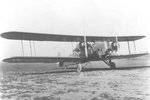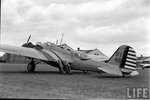World War II was not won by bombers alone, but the use of the heavy, strategic bomber was essential to victory both in Europe and in the Pacific Theaters. The Allied powers, led and principally supplied by the United States, pounded from the air every means of production and transport in the Axis held territories. In addition, fleets of bombers hunted submarines, supported offensives, and thwarted enemy tactics by attacking any concentration of troops or war supplies. The combination of air power, sea power and land armies eventually rolled the aggressor nations back to Berlin and Tokyo, ending the war in 1945.
he WW II Bomber air campaign in Europe was called the Combined Bomber Offensive (CBO), a cooperative effort of the United States and Great Britain aimed at defeating the German war waging capability. From 1942 to 1945, the strategy used heavy bombers to destroy German industrial capabilities, military production facilities, supply lines and communication network, and to pound down the German people's will to fight. This campaign was considered as a preliminary step for the D-Day invasion of Normandy. While the CBO did not alone win the war, it was a necessary component of the total effort which did lead to Germany's unconditional surrender in May 1945.
In the Pacific, bombers were used from the outset of U.S. involvement, starting with the Mitchell Raid on Tokyo in April 1942. Bombing of naval and ground targets was first used to defend against Japanese advances, then shifted to support of the American advances, and finally to strategic bombing of the Japanese home islands. Before the war ended on 2 September 1945 with the unconditional surrender of Japan, thousands of heavy bombers were flying around the clock to destroy every valid target. The atomic bombings of Hiroshima and Nagasaki on 6 August and 9 August 1945, were the most dramatic single attacks, but massive conventional bombing operations were also horribly devastating and effective.
Of the many different bombers used by the U.S. and its allies during World War II, the B-17, B-24, B 26, and B-29 were the workhorses of the U.S. Army Air Forces fleet. The B-25 "Mitchell" and B-26 "Marauder" were medium bombers used mainly at altitudes of 8,000 to 14,000 feet. They primarily supported ground forces by targeting fortified positions, depots, railroad yards and other targets behind battle lines in addition to supplementing heavier bombers on strategic raids. The B-17 "Flying Fortress" was the first of the big bombers used during World War II. It was used mainly by 8th Air Force in Europe but was employed, in much smaller numbers, in the Pacific Theater.
he WW II Bomber air campaign in Europe was called the Combined Bomber Offensive (CBO), a cooperative effort of the United States and Great Britain aimed at defeating the German war waging capability. From 1942 to 1945, the strategy used heavy bombers to destroy German industrial capabilities, military production facilities, supply lines and communication network, and to pound down the German people's will to fight. This campaign was considered as a preliminary step for the D-Day invasion of Normandy. While the CBO did not alone win the war, it was a necessary component of the total effort which did lead to Germany's unconditional surrender in May 1945.
In the Pacific, bombers were used from the outset of U.S. involvement, starting with the Mitchell Raid on Tokyo in April 1942. Bombing of naval and ground targets was first used to defend against Japanese advances, then shifted to support of the American advances, and finally to strategic bombing of the Japanese home islands. Before the war ended on 2 September 1945 with the unconditional surrender of Japan, thousands of heavy bombers were flying around the clock to destroy every valid target. The atomic bombings of Hiroshima and Nagasaki on 6 August and 9 August 1945, were the most dramatic single attacks, but massive conventional bombing operations were also horribly devastating and effective.
Of the many different bombers used by the U.S. and its allies during World War II, the B-17, B-24, B 26, and B-29 were the workhorses of the U.S. Army Air Forces fleet. The B-25 "Mitchell" and B-26 "Marauder" were medium bombers used mainly at altitudes of 8,000 to 14,000 feet. They primarily supported ground forces by targeting fortified positions, depots, railroad yards and other targets behind battle lines in addition to supplementing heavier bombers on strategic raids. The B-17 "Flying Fortress" was the first of the big bombers used during World War II. It was used mainly by 8th Air Force in Europe but was employed, in much smaller numbers, in the Pacific Theater.













































